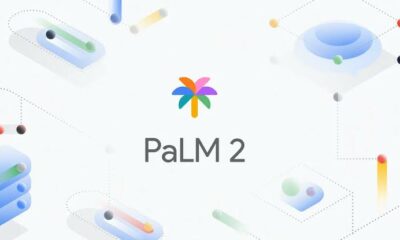
News
How Google Med-PaLM 2 AI Can Answer Medical Questions Better Than a Doctor
Learn what Med-PaLM 2 is, how it works, what are its benefits and challenges, and what are its future directions and applications.

Have you ever wondered if there is an AI system that can answer your medical questions as well as a doctor? If so, you might be interested in Google’s latest innovation: Med-PaLM 2, a large language model (LLM) designed for the medical domain.
In this article, we will explore what Med-PaLM 2 is, how it works, what are its benefits and challenges, and what are its future directions and applications.

What is Med-PaLM 2?
Med-PaLM 2 is a specialized version of *PaLM*, a large language model developed by Google Research that can perform various natural language tasks such as text generation, summarization, translation, classification, and question answering. Med-PaLM 2 harnesses the power of Google’s large language models and aligns them to the medical domain by training them on a diverse and multilingual corpus of medical texts, such as:
– Professional medical exams, such as the United States Medical Licensing Examination (USMLE)
– Medical research papers, such as PubMed and BioASQ

– Consumer health queries, such as WebMD and Healthline
Med-PaLM 2 was introduced by Google Research in late 2022 as the first AI system to surpass the pass mark on USMLE-style questions. It was also evaluated by panels of physicians and users for its ability to generate accurate, safe, and helpful long-form answers to consumer health questions. In March 2023, Google announced its latest version of Med-PaLM 2 at its annual health event The Check Up. Med-PaLM 2 achieved an accuracy of 86.5% on USMLE-style questions, a 19% leap over its predecessor. It also became available to a select group of Google Cloud customers for limited testing.

How Google Med-PaLM 2 AI Can Answer Medical Questions Better Than a Doctor
RELATED: Google AI PaLM2: The Next Frontier in Natural Language Processing
How does Med-PaLM 2 answer medical questions?
Answering medical questions is not an easy task. It requires a combination of medical comprehension, knowledge retrieval, and reasoning skills. For example, consider this USMLE-style question:
> A 45-year-old man comes to the physician because of a 3-month history of intermittent chest pain that radiates to his left arm. He has hypertension treated with hydrochlorothiazide. He smokes half a pack of cigarettes daily. His pulse is 90/min and blood pressure is 160/100 mm Hg. An electrocardiogram shows ST-segment elevation in leads V1 through V4. Which of the following is the most likely diagnosis?
> A) Acute myocardial infarction
> B) Angina pectoris
> C) Aortic dissection
> D) Pericarditis
> E) Pulmonary embolism
To answer this question correctly, one needs to understand the symptoms, examine the findings from the electrocardiogram, perform complex reasoning about the likely diagnosis, and ultimately pick the right answer. The correct answer is A) Acute myocardial infarction.
Med-PaLM 2 can answer this question accurately because it has learned from a large amount of medical texts that cover various topics and scenarios. It can also explain its reasoning process by generating a long-form answer that provides relevant information and references. For example:
> The most likely diagnosis for this patient is acute myocardial infarction (AMI), which is a condition where the blood supply to a part of the heart muscle is suddenly blocked, causing damage or death of the tissue. The patient has several risk factors for AMI, such as hypertension, smoking, and age.
The patient also has typical symptoms of AMI, such as chest pain that radiates to the left arm and lasts for more than 20 minutes. The electrocardiogram shows ST-segment elevation in leads V1 through V4, which indicates an anterior wall infarction involving the left anterior descending artery. This type of AMI is associated with a high mortality rate and requires urgent revascularization therapy.
The other options are less likely because they have different clinical features or electrocardiographic findings. For example:
– Angina pectoris is chest pain caused by reduced blood flow to the heart muscle, but it usually occurs with exertion or stress and resolves with rest or nitroglycerin.
– Aortic dissection is a tear in the inner layer of the aorta, the large blood vessel that branches off the heart. It can cause chest pain that radiates to the back or abdomen and is often described as tearing or ripping. It can also cause differences in blood pressure or pulse between the arms or legs.
– Pericarditis is inflammation of the pericardium, the sac that surrounds the heart. It can cause chest pain that worsens with lying down or breathing and improves with sitting up or leaning forward. It can also cause a pericardial friction rub, a scratchy sound heard with a stethoscope over the heart.
– Pulmonary embolism is a blockage of one or more arteries in the lungs by a blood clot that travels from another part of the body, usually the legs. It can cause chest pain that is sharp and pleuritic, meaning it worsens with breathing or coughing. It can also cause shortness of breath, cough, hemoptysis, or signs of right heart failure.
[the_ad id=”41670″]
What are the benefits and challenges of using Med-PaLM 2?
Using Med-PaLM 2 for medical question answering can have many benefits for healthcare professionals, researchers, and consumers. Some of these benefits are:
– Improving diagnosis: Med-PaLM 2 can help clinicians make accurate and timely diagnoses by providing them with relevant information and suggestions based on the patient’s history, symptoms, tests, and treatments.
– Providing personalized advice: Med-PaLM 2 can help consumers make informed decisions about their health by providing them with tailored and trustworthy answers to their health questions, as well as recommendations for prevention, management, or referral.
– Enhancing patient education: Med-PaLM 2 can help patients understand their conditions and treatments better by providing them with clear and concise explanations, definitions, examples, and illustrations.
– Facilitating information retrieval: Med-PaLM 2 can help researchers and students access and synthesize large amounts of medical literature by providing them with summaries, highlights, and citations.
However, using Med-PaLM 2 also poses some challenges and limitations that need to be addressed. Some of these challenges are:
– Ensuring data privacy: Med-PaLM 2 needs to handle sensitive and personal health data with care and respect. It needs to comply with the relevant laws and regulations, such as HIPAA and GDPR, and protect the data from unauthorized access or misuse.
– Addressing ethical issues: Med-PaLM 2 needs to adhere to the ethical principles and standards of the medical profession, such as beneficence, non-maleficence, autonomy, and justice. It needs to avoid causing harm or bias to the users or patients, respect their preferences and values, and ensure fairness and accountability.
– Avoiding misuse or abuse: Med-PaLM 2 needs to be used appropriately and responsibly for its intended purposes. It needs to prevent or discourage users from misusing or abusing it for malicious or fraudulent reasons, such as self-diagnosis, self-medication, or impersonation.
– Maintaining human oversight: Med-PaLM 2 needs to be supervised and monitored by human experts who can verify its accuracy, reliability, and safety. It needs to acknowledge its limitations and uncertainties, and defer to human judgment when necessary.
[the_ad id=”33485″]
What are the future directions and applications of Med-PaLM 2?
Med-PaLM 2 is currently available to a select group of Google Cloud customers for limited testing. Google is also inviting researchers and developers to collaborate and provide feedback on Med-PaLM 2 through its [official website](https://sites.research.google/med-palm/). Google hopes to explore safe, responsible, and meaningful ways to use this technology in various domains and scenarios.
Some of the possible use cases and applications of Med-PaLM 2 are:
– Telemedicine: Med-PaLM 2 can enable remote consultation and diagnosis between patients and doctors through voice or text-based communication platforms.
– Clinical decision support: Med-PaLM 2 can assist clinicians in making evidence-based decisions by providing them with relevant information, guidelines, recommendations, and alerts.
– Health chatbots: Med-PaLM 2 can power conversational agents that can interact with users on health-related topics, such as symptom checking, appointment booking, medication reminders, or wellness tips.
– Medical education: Med-PaLM 2 can support medical students and educators by providing them with interactive learning materials, quizzes, feedback, and explanations.
– Medical research: Med-PaLM 2 can facilitate medical research by providing researchers with tools for literature review, data analysis, hypothesis generation, paper writing, and peer review.
Some of the ongoing and future research directions and improvements for Med-PaLM 2 are:
– Expanding its multilingual capabilities: Med-PaLM 2 currently supports English as the primary language for medical question answering. Google plans to extend its coverage to other languages and regions by incorporating more multilingual data sources and models.
– Incorporating domain-specific knowledge graphs: Med-PaLM 2 currently relies on textual data for pre-training and fine-tuning. Google aims to enhance its knowledge base by integrating domain-specific knowledge graphs that capture the relationships and concepts in the medical domain.
– Enhancing its explainability: Med-PaLM 2 currently provides some explanations for its answers by citing references or sources. Google intends to improve its transparency and interpretability by generating more detailed and personalized explanations that can justify its reasoning process and highlight its confidence level.
What You Should Know
Med-PaLM 2 is a breakthrough in medical question answering that leverages the power of Google’s large language models for the medical domain. It can answer complex medical questions with high accuracy and generate long-form answers with high quality. It can benefit healthcare professionals, researchers, and consumers by improving diagnosis, providing personalized advice, enhancing patient education, and facilitating information retrieval. However, it also faces some challenges and limitations that need to be addressed, such as ensuring data privacy, addressing ethical issues, avoiding misuse or abuse, and maintaining human oversight. Med-PaLM 2 is currently available to a select group of Google Cloud customers for testing and feedback. Google is also exploring various use cases and applications of Med-PaLM 2 in different domains and scenarios, such as telemedicine, clinical decision support, health chatbots, medical education, and medical research. Google is also working on improving Med-PaLM 2 by expanding its multilingual capabilities, incorporating domain-specific knowledge graphs, and enhancing its explainability.
If you are interested in learning more about Med-PaLM 2 or collaborating with Google on this technology, you can visit the [Med-PaLM official website] or read the Med-PaLM 2 preprint paper You can also check out the Google Cloud blog post on Med-PaLM 2 for more details and insights. We hope you enjoyed this article and found it informative and helpful. Thank you for reading!



























